Claude Monet’s house has a kitchen filled with antique French copper. Let’s take a look.

Claude Monet (1840-1926) is perhaps the most revered French painter of the Impressionist era and his house and gardens in Giverny, outside Paris, are maintained with artwork and furnishings as they were during his residency. I recently had the opportunity to visit, and as much as I enjoyed the gorgeous gardens and charming house, it was the kitchen that took my breath away.
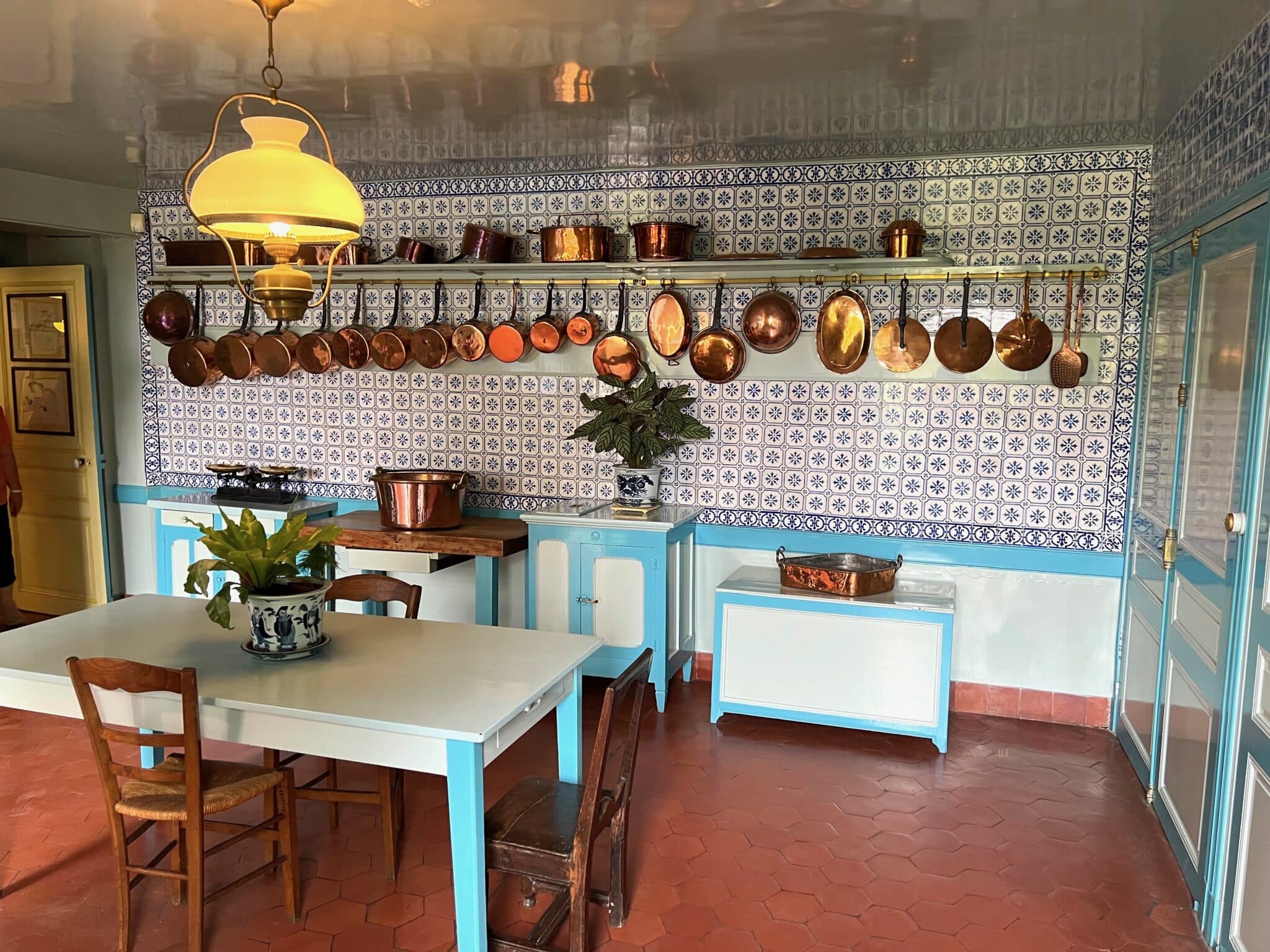
Look at all that copper! I had no idea! And my photos doesn’t even capture all of it!
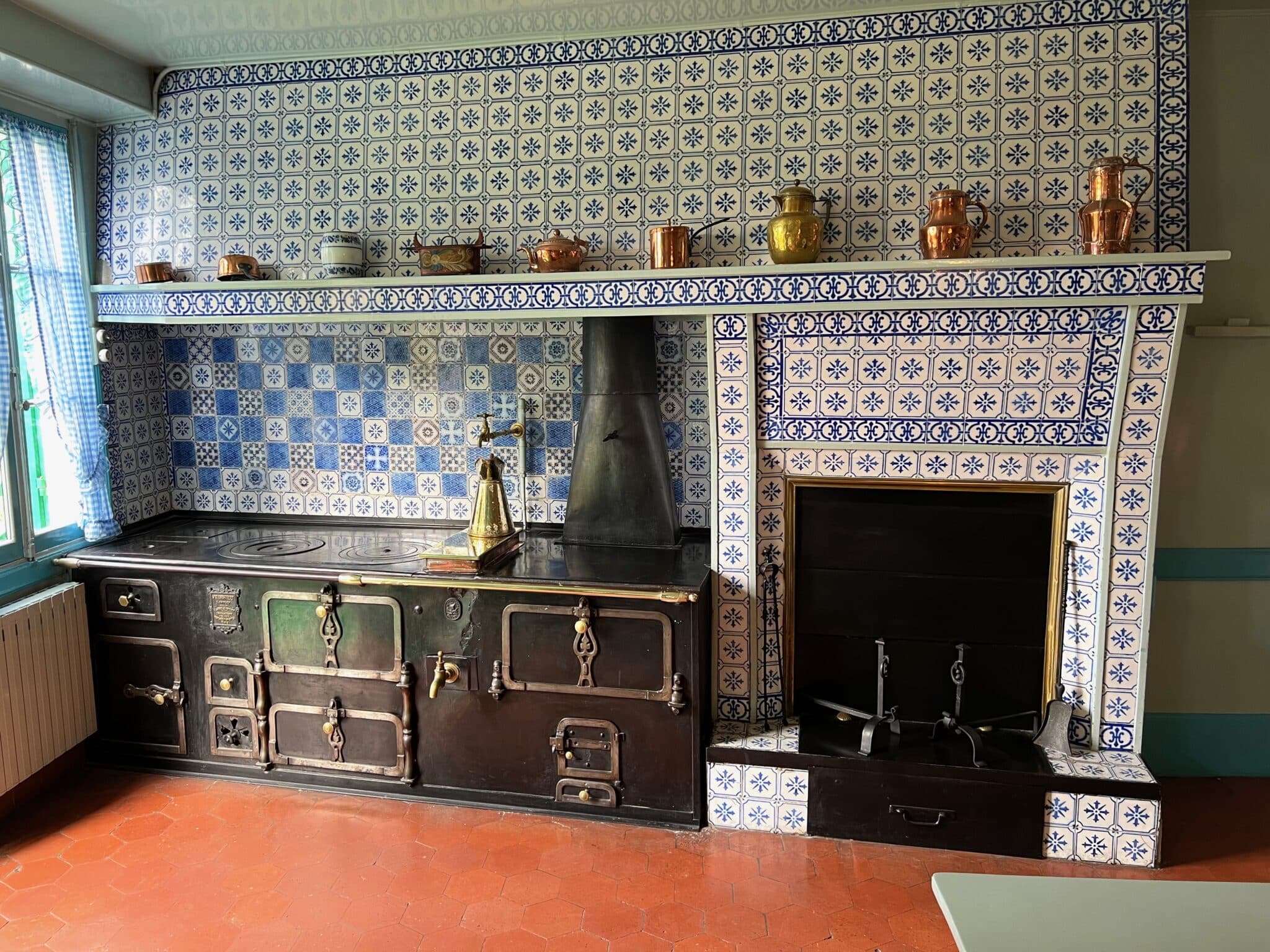
I swung into action to grab as many photos as I could with my cellphone camera. Since my visit, I have spent many hours peering at my photos (and wishing keenly that I had taken a few more from different angles!). What follows is my attempt to bring you something more than just a general appreciation of Monet’s copper collection. I believe that just as Monet’s artwork carries meaning beyond the brushstrokes on the canvas, so too does this collection of pieces have something to teach us.
A quick history
The heyday of Giverny was 1883 to 1926 when Monet was in residence, actively developing the garden while painting and selling art. He hosted a steady stream of artists, writers, philosophers, and politicians for meals of local fish and game complemented by vegetables grown in his garden. According to the lovely book Monet’s Table, he preferred to host luncheons because dinners ran too late in the evening — Monet demanded a good night’s sleep before waking up early to catch the morning light for painting.
After Monet’s death in 1926, ownership of the house and gardens passed to his son Michel Monet (1878-1966), but the place was maintained by Monet’s stepdaughter Blanche Hoschedé Monet (1865-1947). A household and garden staff continued to live at Giverny until 1940 when the Nazis occupied France; the staff evacuated for safety and left the house empty. Fortunately the property and its contents managed to escape destruction: Blanche sent a written appeal to Count Franz von Wolff-Metternich, the person appointed by the German regime to preserve French artworks. Metternich had a sign posted on the door: “This is Monet’s house. Forbidden to the forces of occupation.”
Blanche passed away in 1947 and Giverny fell deeper into neglect. Michel Monet died in 1966 and left the property to the Academie des Beaux-Arts. In 1976 Monet’s house and gardens were declared a historical monument, and the process of restoration began in 1977. The non-profit Fondation Claude Monet was created in 1980 to manage the property. The Fondation secured funds for restoration and maintenance of the house and garden and was able to open the property to the public.
The copper collection
The kitchen has some forty-odd pieces of copper on display. I couldn’t find any information about the collection beyond statements that it is original to the house, and for what it is worth, I think that’s correct. Everything I saw appeared authentic to French production in the late 19th to early 20th century. Most of the pieces are unstamped and impossible for me to identify with certainty, but if we accept that this collection is original to Monet’s occupancy of the house — and I have no reason to doubt this is the case — then this is the batterie de cuisine of a well-appointed private kitchen from circa 1880 to the early 1920s.

I almost stopped my examination after making this assessment of authenticity, but as I continued to study the collection, I began to notice that pieces that appeared identical at first glance proved to have subtle differences in the handle design. They were recognizably French, but compared to the handle designs we know so well, the look of these handles was just slightly off: too flat, or too straight, or not quite the right shape. Furthermore, these differences did not appear to be manufacturing mishaps but rather intentional design variations, suggesting that they were not the work of a backyard poêlerie but rather mass-produced.
What could all these various designs signify? Considering the time and place of this collection, I offer a hypothesis: This collection consists of production from multiple mid- to late-19th century French makers that did not survive into the 20th. If my hypothesis is correct, then Monet’s kitchen serves as a time capsule of 19th century French cookware at a moment of time of extraordinary diversity. What this means for us as collectors and appreciators of this period is that the handle designs we see in Monet’s pieces could help us recognize other unstamped examples that are otherwise difficult to characterize, potentially confirming them to be French production of the same era.
This is why I’ve spent an extraordinarily long time (even for me!) preparing this post for you. Please indulge me as I explain this line of thought.
The Great Consolidation
Towards the end of the 19th century, the French cookware industry was undergoing a profound transition. A chaudronnerie of the early to mid-19th century employed a workshop of smiths who measured and cut sheet metal by hand, bent and hammered the metal into shape over an anvil, and finished the piece and attached the handles. By the late 19th century, steam-powered machines could cut and bend thicker sheet metal into beautifully consistent pieces in a fraction of the time. The one-at-a-time-by-hand production model would have faced stiff competition from this emerging early modern assembly line that used machines to cranked out shaped pots for humans to finish.
 During this same period — the 1890s to 1910s — there occurred what I call the “Great Consolidation”: many small family chaudronneries closed or were acquired by others, so that by the early 1900s the industry was dominated by a relatively few larger firms. Consider Dehillerin: founded in 1885, the firm had by 1910 or so absorbed Personne, Delzangles, Lasnier, Aubry, and Charmois. (See the advertisement at right.) Though there must have been many factors behind this consolidation, I suspect that many family-run chaudronneries were unable to make the transition to — and more specifically, the financial investment in — the machinery required to keep pace with the rest of the industry.
During this same period — the 1890s to 1910s — there occurred what I call the “Great Consolidation”: many small family chaudronneries closed or were acquired by others, so that by the early 1900s the industry was dominated by a relatively few larger firms. Consider Dehillerin: founded in 1885, the firm had by 1910 or so absorbed Personne, Delzangles, Lasnier, Aubry, and Charmois. (See the advertisement at right.) Though there must have been many factors behind this consolidation, I suspect that many family-run chaudronneries were unable to make the transition to — and more specifically, the financial investment in — the machinery required to keep pace with the rest of the industry.
What is significant for our efforts to identify and appreciate copper of this era is that the Great Consolidation also reduced variety in handle design. The beautiful ornate brass handles that graced the delicate hand-shaped pieces by Lasnier and Personne didn’t survive the acquisition by Dehillerin; by the 1910s, the handles on Dehillerin, Gaillard, and Jacquotot pieces are identical to my eye. I suspect the same forces at work in the copper cookware industry also drove consolidation in the metal casting companies that supplied these handles. Whatever the causes, the Great Consolidation at the end of the 19th century produced a French design aesthetic that persisted until the early 21st.
The significance to us, as copper collectors in the present day, is that Monet’s copper collection — compiled between 1883 and 1926 — likely includes French production just prior to the Great Consolidation. Though most of the pieces don’t carry maker’s marks or other elements that could identify them with certainty, I suggest that we can assume they are contemporaries.
Proto-French and classic French
What I propose for this post is to use the term “proto-French” to refer to exemplars of the diversity of design in the late 19th century before the impending evolutionary dominance of what I will call the “classic French” style of the 20th. My goal for this examination is to equip you with more confidence that an otherwise unidentifiable piece with a proto-French handle is likely to be French make from this 1880s to 1900 time period.
This agenda means that this post will not be a typical appreciation of the entire collection. I’ll use the first part of this post to lay out my hypothesis of the proto-French concept and towards the end of the post I’ll return to a few other interesting pieces I spotted. If you’d like to get a more complete sense of the room, I invite you to visit the Fondation Claude Monet website with its “virtual visit” feature, including a panoramic view of the kitchen. You may find that site helpful to orient yourself as I move through the collection.
So let’s get started.
A chronological approach
I’d like to start with an examination of the earliest pieces I saw in the collection — two pans with forged iron handles.

That’s a forged iron handle — the handle shaft is straight and there are visible hammer impact marks along the underside. The baseplate has rough irregular edges because it was hammered to flatten it. The hanging loop is not visible in the photo above (and for that I offer my apologies — I was working quickly and didn’t get all of the photos I should have!) but it has a “rat tail”: the smith cut the iron into a long tapered point and then curled the point back against the shaft to form a loop.
Hanging further down along the rack is another early pan with a handle with the same characteristics.

The forged iron handle on this round-bellied sauté also has straight shaft with visible impact marks, ragged edges along the baseplate where it was flattened with hammer strikes, and a rat-tail hanging loop with a visible seam where the tip of the loop rejoins the handle shaft. Both this pan as well as the one just above show some repaired damage: the saucepan has a hole in the center of the base (more on this later!), and the sauté has a well-executed patch repair on one side. The sauté also has a rolled rim, indicating that the copper was reinforced with a ring of iron to provide some structural rigidity.
Based on the forged handles as well as the apparent thinness of the copper, I assess that the two pieces above are mid-19th century, perhaps 1840s to 1860s or so. Please keep the texture and shape of these forged handles in mind as we look at the handles to come.
Next I’d like to show you the two saucepans below. Their handles are cast iron, and they’re both a little later than the two examples above with forged iron handles. But what else do you notice?

They’re both clearly French: the baseplates have a lozenge shape, three copper rivets arranged in a broad triangle, and a slender handle shaft set in a gentle curve. But side by side, differences become apparent. The baseplate on the left is slightly more broad and is flatter in profile, and the radius of the curve of the shoulder to the handle is less pronounced. By comparison, the baseplate on the right is narrower in span but thicker in profile, instantly recognizable and virtually identical to many 20th century pieces in my own collection.
Using my terminology, that handle on the left is proto-French, whereas the handle on the right is classic French.
There are additional similarities and differences in the hanging loops. In the photo below, the proto-French handle is on the left, and the classic French handle is on the right. What do you notice?

They’ve both got that teardrop shape, but once again they’re different. The proto-French teardrop on the left is larger with a deeply cut notch; the classic French teardrop is smaller with straighter sides, and the notch is marked with a groove. This design survived into the 21st century: pull out a Gaillard, Jacquotot, Dehillerin, or Mauviel iron-handled piece and you’ll see the same groove at the base of the teardrop. (In fact, I would go so far as to suggest that this particular classic French piece may have been supplied by Établissements Mauviel-Gautier Frères in Villedieu. Mauviel claims that its iconic handle was designed by Ernest Mauviel, who took the reins of the family firm in 1880 with his brother Eugène. That is about the right time period for this kitchen collection.)
Here’s another proto-French handle. What do you see?

This handle looks almost like a forged iron but I think it’s an early example of cast iron. I don’t see impact marks on the surface, and the edges of the baseplate curve smoothly to meet the pan body and don’t show fractures or ragged edges from flattening. But I could be wrong. The hanging loop looks irregular for a cast piece, and there is a slight seam that resembles a rat-tail join (though it’s not quite in the right place). The handle shaft is straight like a forged handle would be, and the transition from baseplate to shaft is an abrupt angle. Could the casting mold have been formed from a forged iron handle?
Moving along the rack, we come to two more pieces worth a look.

The handle on the small saucepan on the left resembles the classic French style but it only has two rivets. The classic French aesthetic is for three rivets, even for diminutive pieces like this that would be quite unlikely to need such reinforcement. I would posit that this is another early proto-French design conceived before the three-rivet format became the expected French standard. The handle is cast, not forged or wrought, and so with its unusual design I would tentatively date it to 1890s to early 1900s.
The sauté on the right has a cast handle with a flattened profile. Note the smooth slope where the edge of the baseplate meets the pan sidewall, compared to the bulged “pillowy” look of the edges of the baseplate on the small saucepan to the left. In texture and profile this handle reminds me of the saucepan example just above, but the transition from baseplate to handle shaft is a curve, not a distinct angle.
Moving along, here are two more pans to compare.

The brass handle on the saucepan on the left is classic French. I think this is pre-WWII, possibly 1920s, which would make it one of the latest pieces in the overall collection. Its brass handle marks it as service à table — table service grade, 2mm thick or less, intended to present cooked food at the table — and its unmarred base suggests that it was indeed kept off the stovetop.
The smaller saucepan on the right has what looks like a classic French handle in cast iron but with one odd feature: “R20” is cast into the underside of the handle shaft. That isn’t a size notation — the brass-handled saucepan on the left is truly 20cm diameter, and it’s larger — and so I suspect R20 may have been a mold number or a sequence number. The baseplate of the handle has the pillowy look of the classic 20th century Mauviel-esque style but the hanging loop doesn’t look quite right — it is missing the notch. Though this handle is quite similar to a classic French handle, its R20 stamp and hanging loop make it proto-French in my book.
For the final piece in this close examination, I offer one of the youngest pieces in the collection. Yes, it is stamped for ease of identification, but even before we zero in on that mark, what do you see in the handle and the gorgeous piece itself?

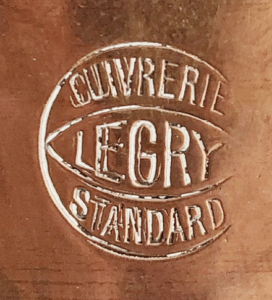 That fish-scale-like hammer patten on the copper sets this piece apart visually from the rest of the collection and is an important clue to its age and era. I call this hammering martelage and I see it appearing on pieces of 2.5-3mm thickness or greater, which according to my research and observation began to emerge in the French cookware industry in the 1890s.
That fish-scale-like hammer patten on the copper sets this piece apart visually from the rest of the collection and is an important clue to its age and era. I call this hammering martelage and I see it appearing on pieces of 2.5-3mm thickness or greater, which according to my research and observation began to emerge in the French cookware industry in the 1890s.
Those of you who track stamps as closely as I do will have recognized the round version of the stamp for Paul Legry, a wonderful French coppersmith who produced very high quality and desirable copper from 1896 into the 1930s. This is one of two stamps I have seen for this firm, and I suspect this version came into use in the 1920s. As noted above, Claude Monet passed away in 1926, which suggests that this piece — almost a century old, as of the writing of this post in 2023! — is one of the youngest in the collection.
Summary
If you accept the Fondation Claude Monet’s assertions that the kitchen copper is authentic to Monet’s residency there, as well as my own amateur assessments of the age of these pieces, then the collection represents a sort of time capsule of French cookware across the 1880s to 1920s, including “proto-French” designs that didn’t survive into the 20th century. My hope is that if you make a note of the characteristics of the handles on these pans, you can more confidently characterize similar pieces to this same era.
With that in mind, here are some differences I observed between classic French and proto-French handle designs.
| Classic French | Proto-French |
|---|---|
|
|
|
|
|
|
|
|
|
|
Odds and ends
I’d like to finish this post by highlighting a few more pieces that are worth noting. To start with, the saucepan collection includes two with handles that we know quite well!


These pieces were sold by Grands Magasins du Louvre, a department store in Paris that sold copper cookware between 1887 and 1914. I would expect these pans to be 2mm thick, the “home cook” grade that Grands Magasins du Louvre (and its competitors Allez Frères and À La Menagère) sold at a fixed price. According to Monet’s Table, Claude Monet and his wife visited Paris regularly to shop and dine, and I find it quite likely that they shopped at Grands Magasins du Louvre for housewares as well. I also draw your attention to the circular marks in the copper — indication of use on Monet’s stove, which I will discuss in an upcoming post.
At the end of the long kitchen rack are three lids and two écumoires. The lids have handles that could be considered proto-French as well!

The largest lid, on the left, looks similar to the classic 20th century “lollipop lid” but if you look closely it’s not quite the same. The lid handles I see on pieces from Mauviel, Dehillerin, Gaillard, Jacquotot, and the other prominent makers of the late 19th into the 20th century have a smooth tapered shape across the top of the lid, but the handle on this lid has more pronounced contours and a distinctly flattened area for the edge rivet. Once again, it’s not quite the uniform French style that emerged by the early 20th century, and for this reason I think it’s another early proto-French design, perhaps 1880s-1890s, at the start of the cast iron era but before the aesthetic had settled.

I think the other two lids are earlier. They share a three-rivet handle design — there are two rivets at the edge, and the handle widens noticeably to accommodate them. But if I am not mistaken, the handle on the middle lid is forged, not cast iron. (Notice how straight the handle shaft is!) I associate a forged handle — as well as a pure copper handle such as the one on the lid on the right — with the era before cast iron became commercially available (gradually between the 1860s and 1880s, almost universally by the 1890s).
Here is a close-up shot of the copper-handled lid. I find it really beautiful.

Hanging next to the lids are two écumoires. I just love these things. These are tools to skim floating fat from the surface of simmering stock to clarify it. Antique versions like these are made from solid copper, though I would not be surprised if the copper sheet of the shaft were folded around a reinforcing strip of some kind to lend some rigidity. Seeing these long-handled pieces, I would have expected also to find stockpots in the kitchen, but I did not see any pieces deep enough to warrant them.

There are a few more pieces arranged along the shelf above the hanging rack.
Below are two poissonières with brass handles. I could not see whether or not they retained their perforated lifter. I did not see lids, but my study of French cookware catalogs from the 19th and early 20th century shows that poissonières were not routinely sold with lids until the mid-20th century.


Next along the shelf is this interesting oval cocotte. The side handle is made from a copper rod bent into shape and flattened to take rivets. This is not a very resilient design for a handle. Unreinforced copper is quite flexible and in fact the handle on the other side of the pot has snapped off, right at that 90-degree bend. I think this is another early piece, 1860s-1870s or so.

Below the array of saucepans, set upon a small standing cupboard, is a lovely turbotière complete with its lifter. Like the poissonières, it does not have a lid. The handle here looks quite similar in style to the ones on the two fish poachers up above and it’s possible they came from the same maker around the same time. The styling of these pieces had not changed much, and so I cannot be specific about its time period, but the ornate handle suggests it was made as early as the 1880s into the 1920s.


The basin below resembles a jam pan but I suspect with its deeper sidewalls it is actually a chaudron à blanchir for blanching vegetables. It is unlined because it was intended to be used only with hot water. I am not quite sure how the rolled rim got its brass edge; the pan looks to be solid copper to me, so perhaps a decorative layer of brass was applied. Readers, any ideas?

Moving to the shelf above the stove, there are a few more pieces that caught my eye.
These pitchers are beautiful — I don’t know anything about pieces like these and I can’t speculate about their age or make. They look beautifully made to me and the workmanship on the taller pitcher on the tight reminds me of the all-copper lid we saw above. I wonder if they could be contemporaneous?


Another thing I don’t know much about? Teapots. This one is quite pretty.

Here is a charming bain marie pot. That handle appears to me to be cast iron and the baseplate and handle look to be the same style I see on bains maries going back to the late 19th century. The baseplate shape is an inverted triangle and at first glance it’s easy to confuse it with the English inverted arrow baseplate. However, the French version has soft contours and rounded sides while the English version has more sharply defined points and straight sides.

My friends, I’d like to thank you for your patience with this long post. It has taken me an inordinate amount of time to put this post together, as I found it difficult to articulate what I was seeing. I hope the “proto-French” concept resonates with you. I confess that it is my habit to hunt stamps for my copper collection and I have passed over many unstamped pieces that I now suspect were proto-French and therefore more precious than I realized. Working through this post has prompted me to reconsider my collecting strategy. I may never be able to identify the specific makers for pieces like these, but my hope is that by placing them in their rightful era, we can at the very least recognize them as work from a thriving period of production that offers us a bounty of variegated French designs.
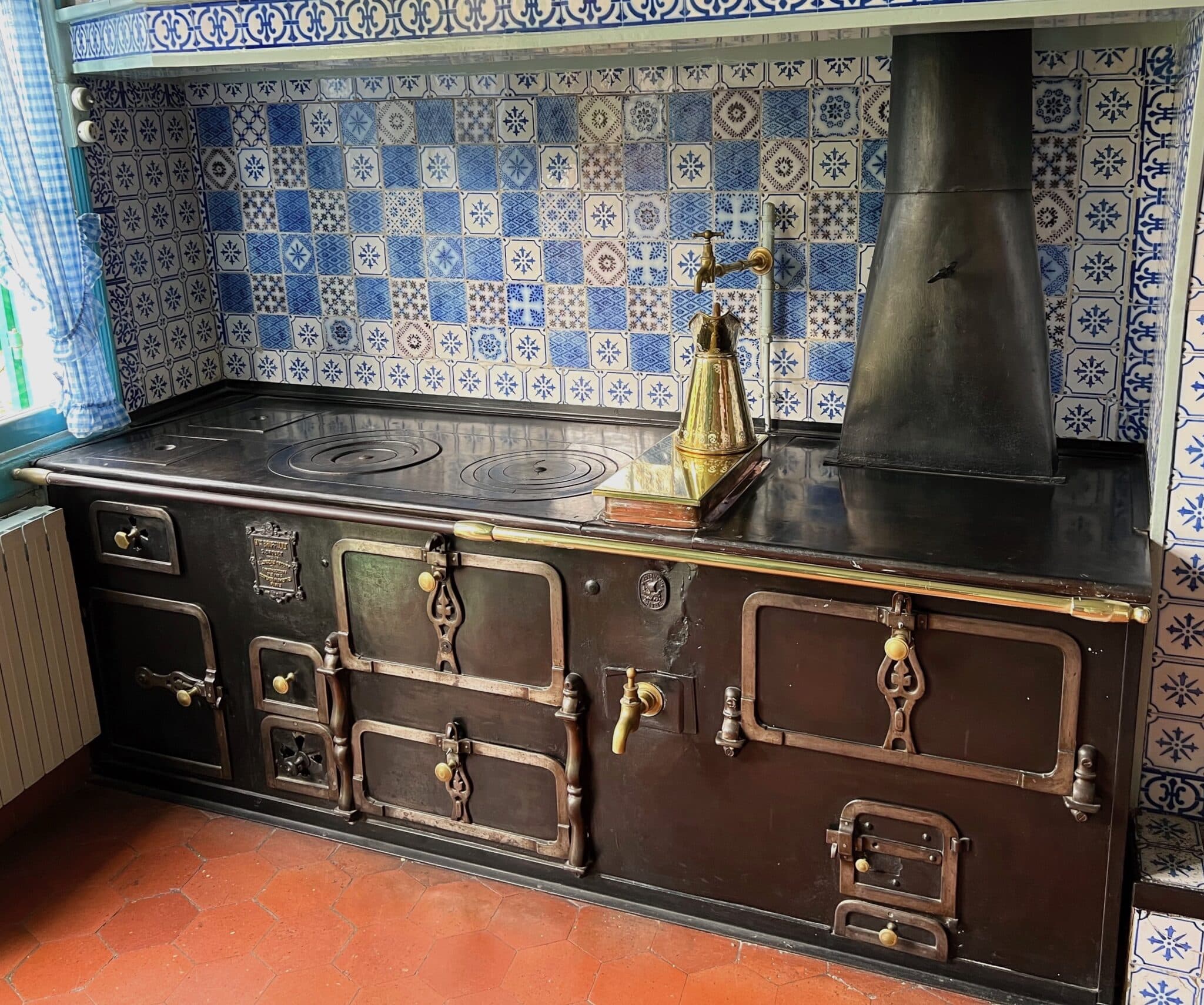
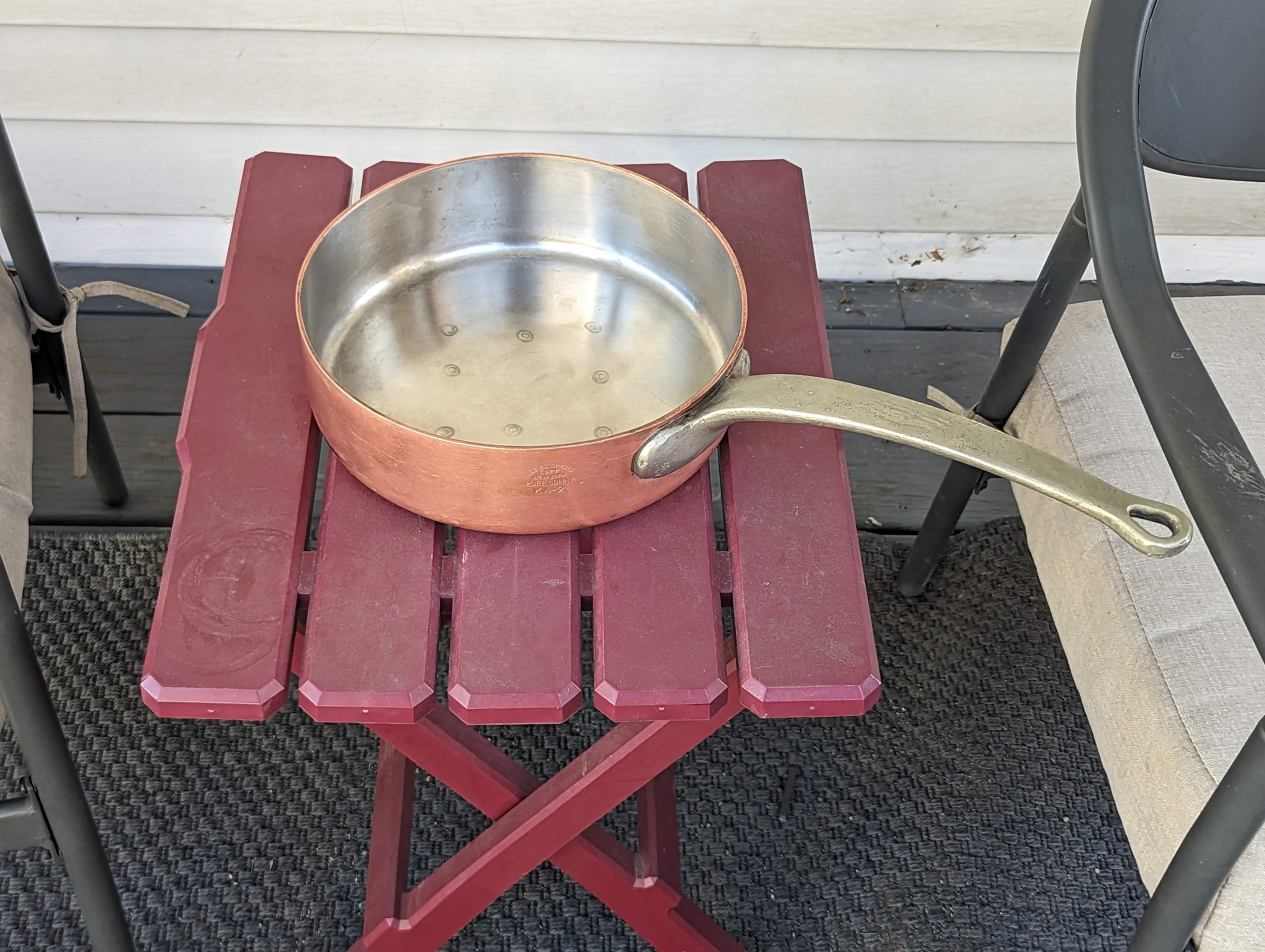
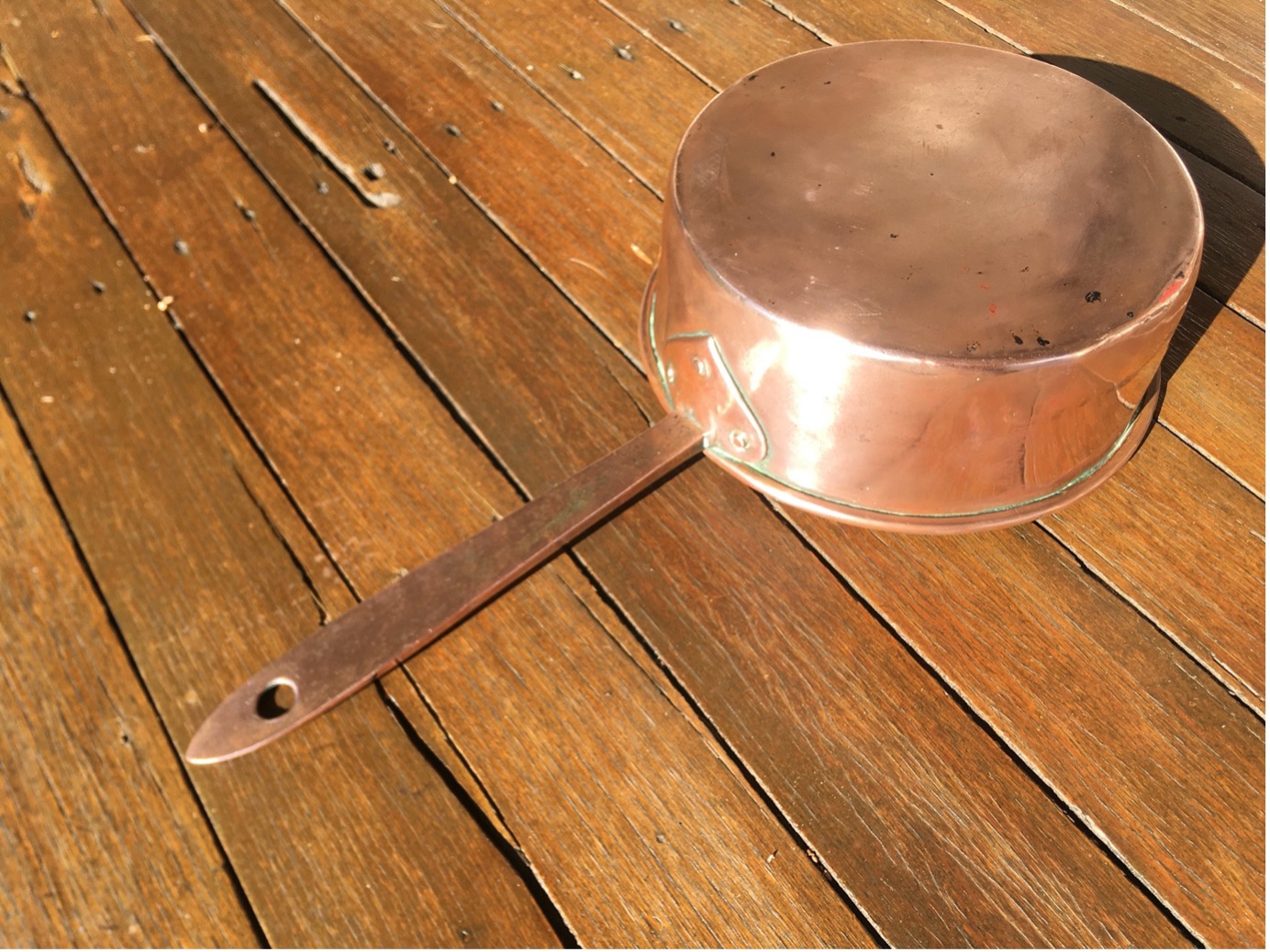
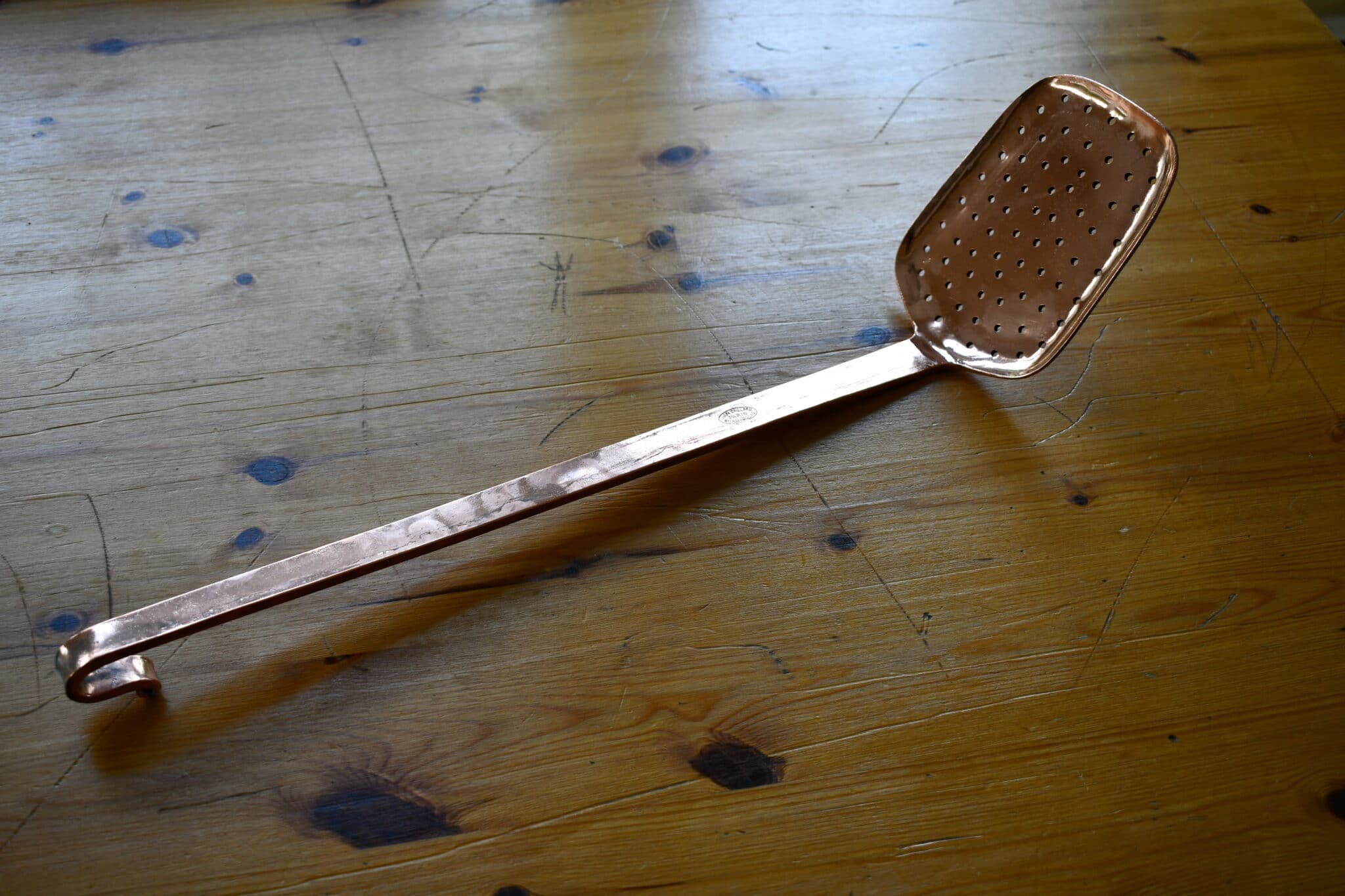
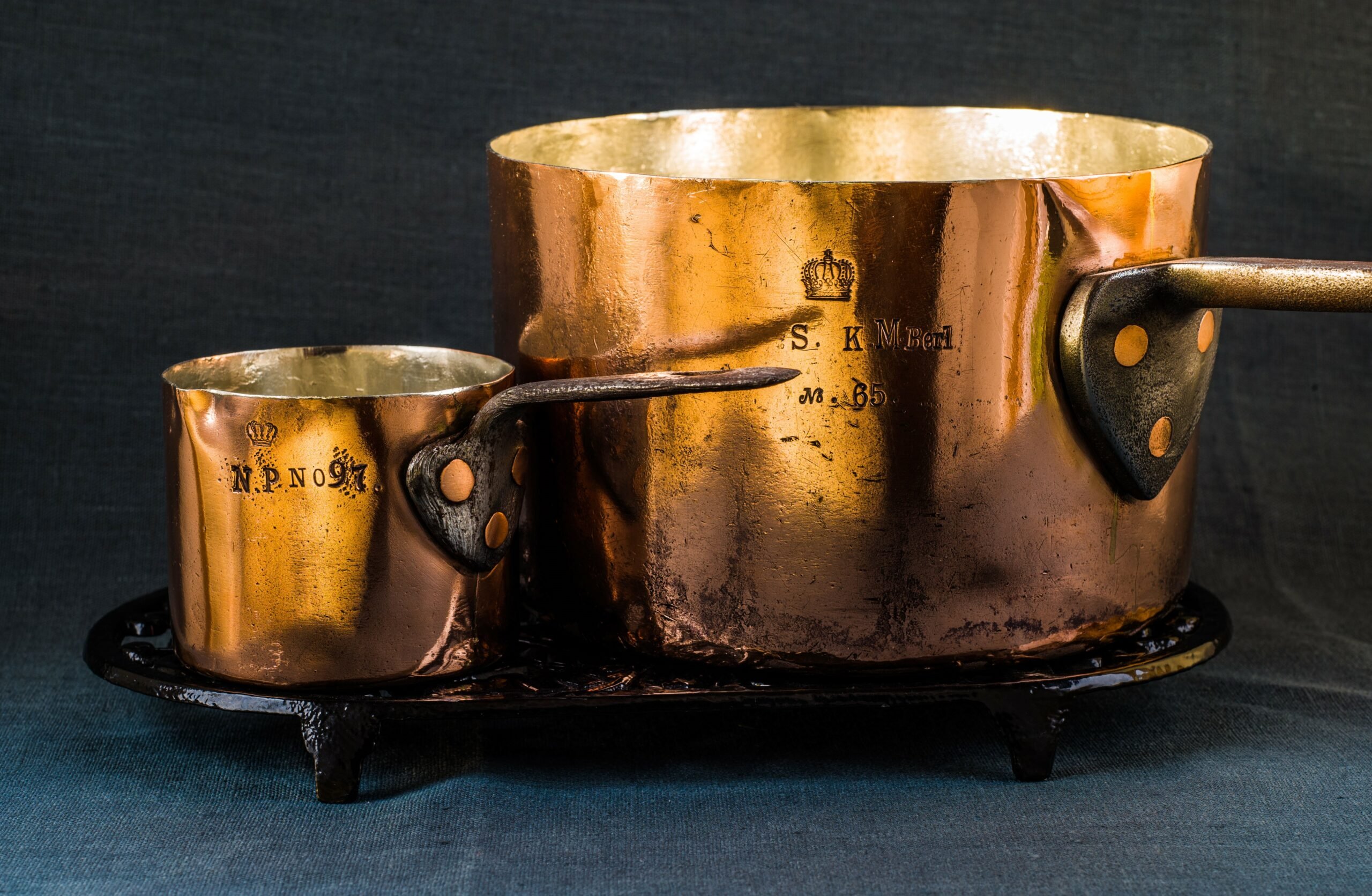
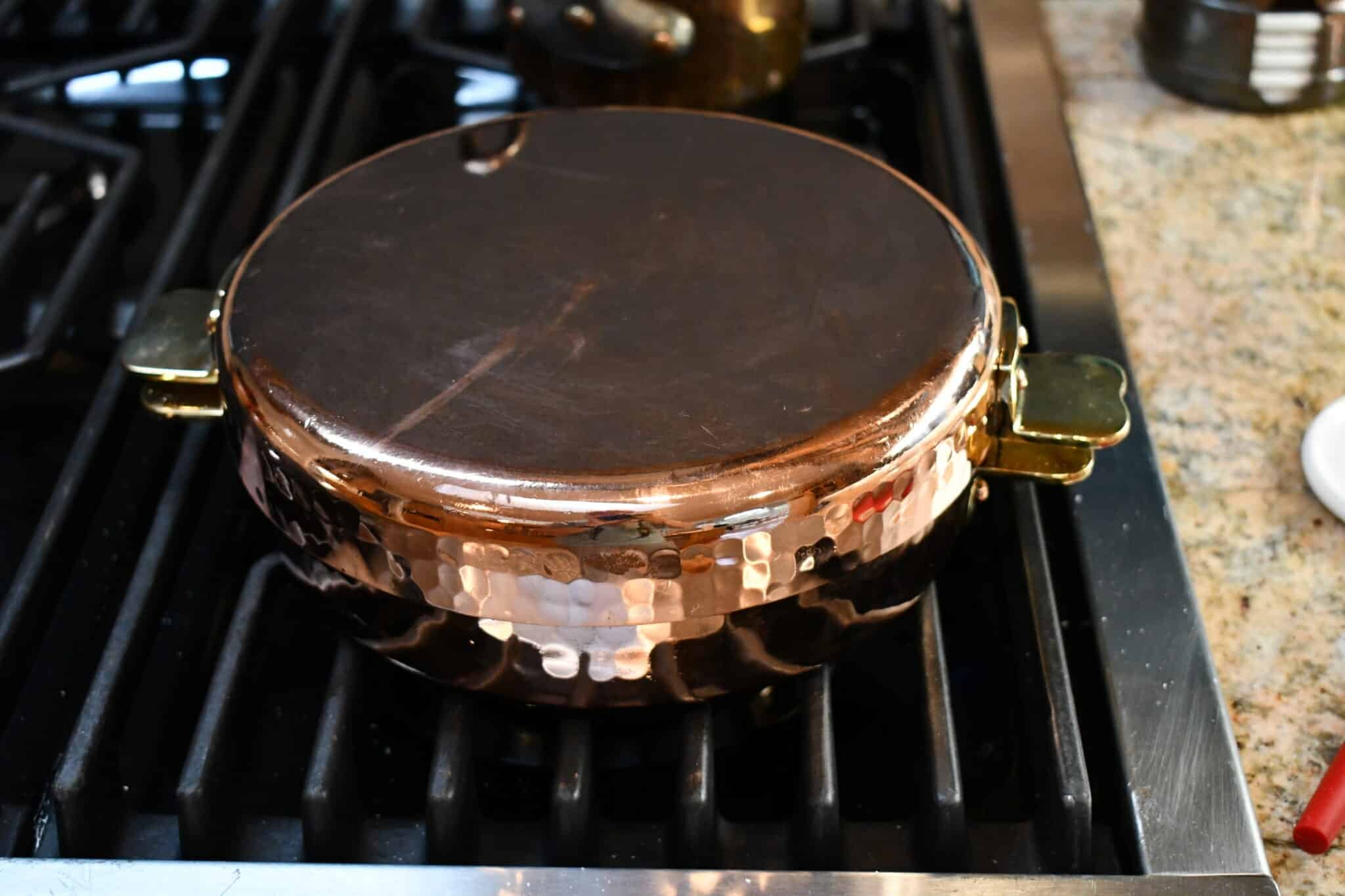
I am absolutely thrilled to be able to see Monet’s kitchen with its countless charming details. For a more detailed study of the copper I need time, which I will take to enjoy everything. Thank you so much for this wonderful report.
Thank you for this enchanting insight. The kitchen is extremely charming. I wish I was there.
Is it known whether Monet cooked himself?
Best regards
Thank you for the post. I was just there a couple weeks ago and was initially scolded for touching a piece by the attendant that was sitting in a chair in the kitchen. I do have additional pictures if that is of interest to you. I would highly recommend that if you have the opportunity to visit Chenonceau Castle it will be worth your effort. I had limited time to spend in the kitchen but it was a wonderland of copper. I saw pieces there that I had no idea as to their function but since have discovered their purpose. I could have spent hours there but unfortunately on a bus tour time was limited. I’ll be posting to Reddit the Chenonceau pictures for all to view.
Hi Terry, last May I was also in Chenonceau and can only confirm your impressions! It is incredible what copper treasures can be found here. Especially the collection of historical bakeware has thrilled me.
I am very excited about your report. The pictures have to put me off until I can travel to France again.
VFC, I assume you’ll have some more to say about the stove in Monet’s kitchen in Part 2 of your report. After all, what good are pans and pots without a stove? I’m dying to do this myself, since I not only recognized the manufacturer, but also know how to cook on this type of stove (hob) and what its special features are. Needless to say, I’ll be waiting (im)patiently for part 2 when you unravel the mystery.
Martin, yes, I have a post in the works about this stove! I hope you can explain some of its quirks!
My grandmother and later an aunt cooked on this type of stove. My mother also had a much smaller one as a side stove next to her electric stove. But I’m sure if you write a post about this stove, I won’t be able to add much. In any case, it’s great that the focus is finally on a stove.
Very interesting post showing details of 19th century copper pans. That beautiful stove brings to mind the luxury stoves made by La Cornue.
The direction is correct, but it is another manufacturer that has already left a trace in VFC. You can find “monsters” of this stove in quite a few palaces.
Doing a little research, I see that is the brand offered in the early Gaillard catalog.
How funny, VFC should include search games like this in their posts more often! The pictured stoves from a Gaillard supplier do bear some resemblance to the stove in Monet’s kitchen, but I suspect the painter treated himself to something more exquisite.
As I leafed through a few more catalogs on this occasion, I was amused by the “distorted” perspectives in the depicted objects. I assume the draftsmen deliberately combined several perspectives in one illustration to make the details of more complex objects as recognizable as possible. A kind of utilitarian cubism.
A little further research indicates that this is a Briffault brand stove that was purchased by Monet in Paris. This brand was offered in the Gaillard catalog.
Thank you very much for this wonderful article with your usual good research! About a year ago I stumbled by chance on a link to the Fondation Monet and was totally thrilled by his house and especially his kitchen. It is great fun to do the 3d tour of the building. It’s very high on our to-do list to see it in the original.
I have a small Legry pan that I found at a Paris flea market, and paid all of €10 for. I already liked it, but even more knowing that one of its brethren is at Monet’s house!
bonnie in provence
Reply to the last comment by Stephen Whalen from October 17 (the reply button was unfortunately missing at this point):
This is exactly the manufacturer I meant. But a bit of a pity that you have already solved the mystery now, before part 2 of the post was published. The plaque affixed to the front of Monet’s stove can be deciphered quite well if you greatly enlarged VFC’s high-resolution photo. However, in the Gaillard 1914 catalog, I can’t see any inscription on the two stoves that are only drawn, but I can see a plaque as well. As far as I know, there were several manufacturers of such stoves at that time, so I was not sure from which Gaillard was supplied.
Martin, I was not able to enlarge VFC’s photo but I saw that the shape of the decorative badges mounted on the stove’s photo look exactly like the badges seen on the stoves in the Gaillard catalog.
I recently acquired a Gebr. Schwabenland Coffee Grinder, wondering if there is any interest in this piece. It is item number 2253 from the catalogs. Copper plaque and copper top.
Hey, I have more copper than Monet. 🙂 I like the wall storage. The shelf with the bar under it and a long wide wood board for the rims to hit. Seems that’s how they did it back in the day. I recall an old house with a similar kitchen in New England.
I will enjoy my handheld electric whisk, blender, digital scale and thermometer. Sometimes when making a cake, I think, “wow, people did this by hand.” Nice pictures. Okay copper. Beautiful house and kitchen. I guess I am biased to my copper.
For me it’s always hard to buy new copper. Each new piece requires care and commitment. My last purchase was a nice consomme pot. Which I enjoy very much.